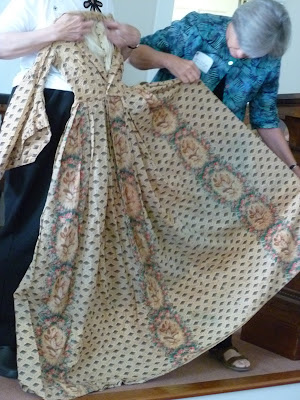
On August 14 I attended a Quilt and Textile Study Day covering textiles from 1840-1860. It was organized by Sharon Pinka, and held at the Lexington Congregational Church in Lexington, OH. If you thought the Show and Tell from my previous two posts was amazing, wait till you see the quilts and coverlets I saw here!
We started at 9 with a meet and greet at the church and registration. People also brought items for a silent auction to benefit the Quilter's Hall of Fame, and this was set up in the basement of the church. In the back of the room the program was to be held in we were greeted by an amazing array of quilts displayed on one side, and coverlets on the other.


At 9:30 the program began with a slide show and talk by quilt historian Xenia Cord about the social, cultural and political climate during the 1840-1860 time period. Xenia started with the fact that the population of the United States in 1840 was 17 million, of which 2.5 million were slaves. She talked about the different types of houses, starting with the single pen, and adding on rooms and stories until we ended up with a Georgian home. We learned that the first patchwork design was published in 1835, and Godey's started publishing in the 1840's. Being of Irish descent, I found it fascinating to learn that the potato famine was so devastating that the population of Ireland will not reach it's pre-famine population until 2025. Xenia also talked about the invention of mercerized cotton, batting sheets, and aniline dye.
With that background, the stage was set for Dr. Virginia Gunn's talk on Century Clothing Construction and Quilt Construction: Recognizing the Connections. She gave us a handout covering the various stitches used in clothing construction, and illustrated these using the teaching collection of clothing from the University of Akron, where she is on staff. These textiles were amazing. Virginia was a flurry of motion, and most of my pictures had either her or the clothing a blur, but we were allowed to handle and photograph it after the talk, and I got lots of close-up shots of the detailing on the clothing. I was especially interested in the children's dresses, with an eye out for ideas for doll costuming. She showed the how the various stitches used in clothing construction were then used in the construction of quilts.





Virginia showing a quilted baby bonnet.

Alright, I admit I'm a fan of soutache trim, which you already know if you've been reading my blog. :)





The next speaker was Kathleen Addlesperger, who showed us the Jacintha Cook quilt from the collection of the Richland County Museum, which was next door to the Church, and gave a talk on the history of the quilt. This amazing white whole cloth quilt was made in 1842 as a wedding quilt, but for reasons unknown the wedding didn't take place and the quilt was packed away for years. Because the design was hard to see, Kathleen had a tracing she made of the legend Jacintha quilted around the center of the quilt.



For the next segment Xenia gave a talk on the typical styles of quilts from the time period 1840-1860. We received a handout with pictures of quilts illustrating the various types of quilts such as Baltimore Album, Princess Feather, and a Chintz and Toile Lemoyne Star Crib Quilt among others. We also saw quilts from this period brought by Sharon Pinka and others, including the Crib Quilt mentioned, which was truly breathtaking.
A appliqued Meandering Leaf and Vine quilt, c. 1860, from Sharon Pinka's collection.

And the chintz and toile crib quilt, c. 1840. I have about a dozen pictures of this. I must have really liked it!






















